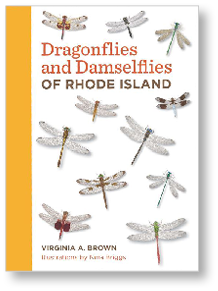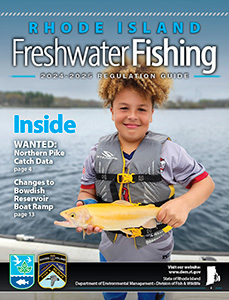Publication Corner
RIDEM Division of Fish and Wildlife’s Publications:
Dragonflies and Damselflies of Rhode Island

By: Virginia Brown, Illustrated by Nina Briggs
Dragonflies and Damselflies of Rhode Island, a compilation of three decades of inventorying and monitoring dragonflies and damselflies inhabiting the state. This is the first time these species have been comprehensively compiled and identified in a publication specific to Rhode Island.
Price: $20.00 purchase by mail (check or money order only).
Order form available by emailing [email protected] or from:
http://www.dem.ri.gov/programs/fish-wildlife/publications/index.php
Inland Fishes of Rhode Island
By: Alan D. Libby, Illustrated by Robert Jon Golder
RIDEM Division of Fish and Wildlife published Rhode Island’s first freshwater fish guide, which identifies more than 70 fishes found in over 377 pond and stream locations throughout Rhode Island! With gorgeous color images as well as black and white scientific illustrations, each fish is addressed with a detailed description and color location map. Originally $26.75, this publication has been reduced to $18.75! This is the perfect gift for any angler!
Amphibians of Rhode Island
By: Christopher J. Raithel
Amphibians of Rhode Island provides meticulous accounts of the state’s 18 native frogs, toads, and salamanders and their respective habitats accompanied by beautiful photographs depicting multiple life stages. Far more than a field guide, the author combines an exhaustive search of the historical record and four decades of intense personal study to provide comprehensive information on the state-wide distribution, demography, seasonal movement, reproduction and development, research needs, and conservation status of each species.
Price: $20.00
Purchase Options for Inland Fishes in Rhode Island and Amphibians of Rhode Island:
- DEM Division of Boating and Licensing located at 235 Promenade Street, Providence. Cash, check or credit (with $1.50 convenience fee).
- Great Swamp Fish and Wildlife Headquarters located at 277 Great Neck Road, West Kingston, office hours 8:30am–4pm, check or money order only.
- On-line, mail-in order form: Print, complete and send along with check or money order only https://dem.ri.gov/natural-resources-bureau/fish-wildlife/reports-publications.
Ways to stay informed:
- Sign up for our ‘Wild Rhode Island’ Newsletter to keep up-to-date with RI DEM Division of Fish and Wildlife. The full-color quarterly newsletter is available online only. For more information or to be added to our email list, please contact Sarah Riley at 401-789-0281 or [email protected].
- Kids can sign up for the ‘Wild Rhode Island Explorer’, a quarterly magazine just for kids, available on-line or in full-color print. This publication features interviews with biologists, information about native species, and so much more! For more information or to sign up, email [email protected].
- Monthly Fish and Wildlife Outreach email: Receive free, up-to-date information about fishing, hunting, and wildlife outreach events as well as Division volunteer opportunities. To sign up, please contact [email protected] or [email protected].
- Follow us on Facebook: Rhode Island Fish and Wildlife Outdoor Education @RIfishwildlife or www.facebook.com/RIFishwildlife. Get event updates, up-to-date stocking information, learn about RI species, and more.
- Follow us on Instagram @ri.fishandwildlife.
Tips for Releasing Live Fish
If fish are to be taken as part of the daily creel limit, they should be killed immediately and kept cool until they can be prepared for the table. If an angler wishes to release a live fish, either because it is undersized or because they are practicing catch and release fishing, the following procedures are recommended:
- Land the fish as quickly as possible to minimize stress to the fish. Playing a fish to the point of exhaustion will lessen its chance for survival.
- Wet your hands before handling the fish; dry hands will remove the fish’s protective slime layer and leave the fish open to bacterial and fungal infections.
- Handle the fish carefully. Do not use excessive force when grasping the fish. Do not put fingers into the gill cavities or eye sockets. A wet glove can be a useful aid in grasping the fish because it reduces the amount of pressure needed to hold the fish securely.
- Gently remove the hook to minimize damage. A pair of long-nose pliers will make the job easier.
- If you are intentionally practicing catch and release fishing, use artificial lures with single, barbless hooks, or circle hooks to minimize damage to the fish.
- Do not attempt to remove a hook that is deeply embedded in the gullet. Instead, cut the line off as close to the hook as possible and release. The fish will have a better chance of survival if the hook is left in place; the hook will eventually disintegrate.
- Return the fish to the water as quickly as possible. Lower it back into the water in an upright position and move it back and forth in the water to force water across its gills. Once the fish revives, allow it to swim away.

